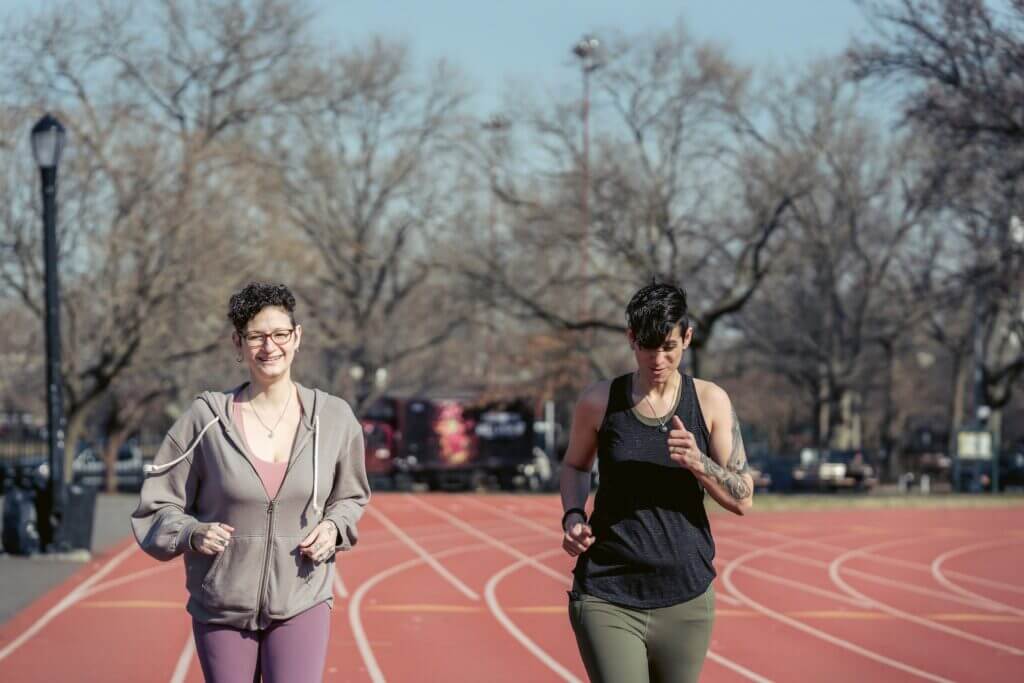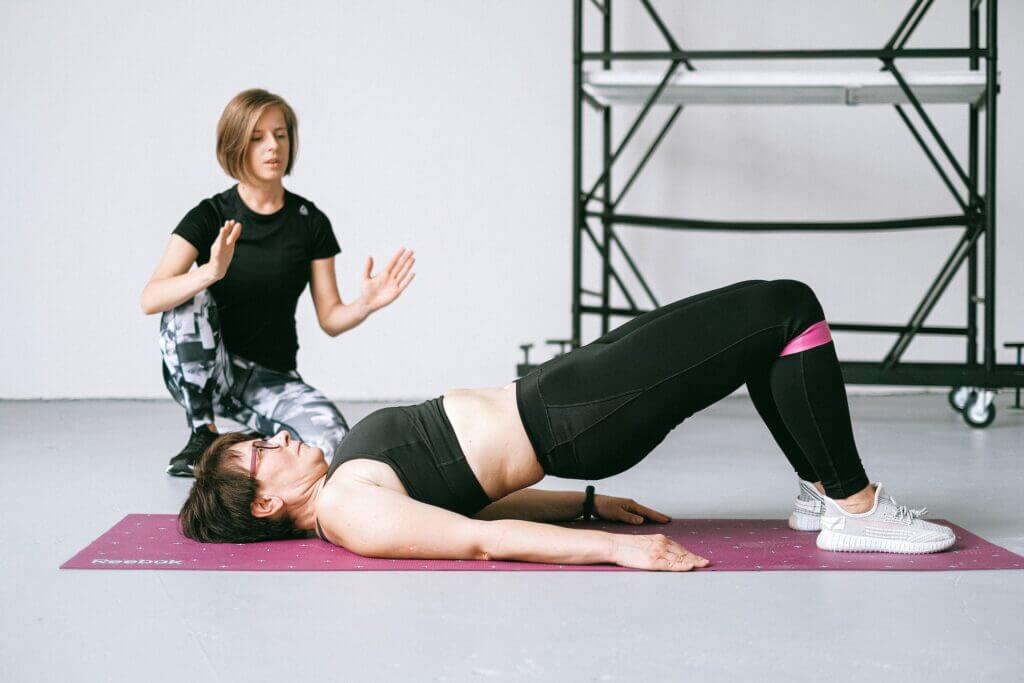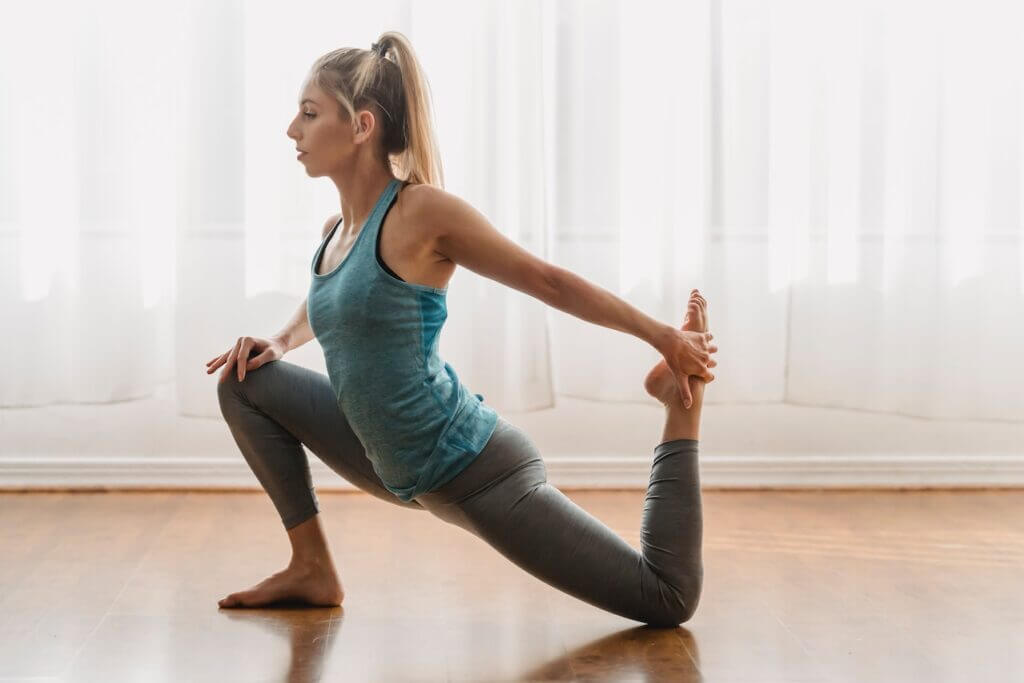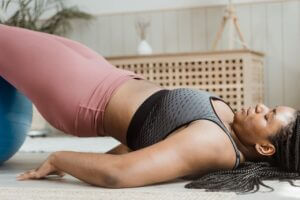If you’re an avid runner, you know how important it is to have strong and stable hips. The hips play a critical role in running efficiency, power, and injury prevention. But with all the different exercises out there, it can be challenging to know which ones are the most effective for runners.
That’s why we’ve put together a list of the top 10 essential hip exercises that every runner should include in their training regimen. Whether you’re a beginner or an experienced runner, these exercises will help you build a strong foundation, reduce the risk of injury, and improve your overall performance. So, grab your workout gear, and let’s get started!
Table of Contents
The Importance of Strong Hips for Runners

When we think about running, we tend to focus on the legs, but did you know that the hips play a crucial role in running efficiency? Your hips are the foundation of your running form, connecting your legs to your core and allowing for smooth, stable movements. When your hips are weak, you’re more likely to experience imbalances, poor form, and injury.
For runners, strong hips can mean the difference between finishing a race with ease and struggling to reach the finish line. Strong hip muscles, such as the glutes, hip flexors, and abductors, provide stability, power, and support to your lower body as you run. These muscles help you maintain proper form, reduce stress on your joints, and generate the force needed for each stride.
In addition to improving running performance, strong hip muscles can also prevent injury. When your hip muscles are weak, other muscles in your body may compensate, leading to overuse injuries in your knees, ankles, and feet. Hip exercises help correct imbalances and prevent these types of injuries from occurring.
Whether you’re a beginner or an experienced runner, it’s essential to prioritize hip exercises in your training routine. By incorporating hip exercises into your workouts, you can build strength and improve your running efficiency, helping you reach your goals and enjoy running with less risk of injury.
So, don’t neglect your hips – give them the attention they deserve and watch your running performance soar!
10 Essential Hip Exercises for Runners
Are you ready to strengthen your hips and improve your running performance? Here are 10 essential hip exercises that every runner should try!
#1 Clamshell
The Clamshell exercise might sound like something you’d find in the ocean, but it’s an excellent hip exercise for runners. The Clamshell targets your glutes and hips, helping to strengthen the muscles that support your lower back and pelvis while you run. Here’s how to do it:
- Start by lying on your side with your knees bent, and your feet together. Make sure your head, shoulders, and hips are all aligned in a straight line.
- Keeping your feet touching, lift your top knee as high as you can without moving your pelvis or lower back. You should feel a squeeze in your glutes as you lift your knee.
- Slowly lower your knee back down to the starting position, keeping your feet touching. Don’t let your pelvis or lower back move as you lower your knee.
- Repeat the movement for 10-15 reps on each side.
The Clamshell exercise is great for runners because it targets the gluteus medius muscle, which is often weak in runners. Strengthening this muscle can help improve your running form and reduce your risk of injury. Plus, it’s a relatively simple exercise that you can do at home with no equipment necessary.
To make the Clamshell exercise more challenging, you can add a resistance band around your knees or ankles. This will add extra resistance and make the exercise more difficult. You can also try doing the exercise with your legs straight instead of bent, or by holding your top leg in the air for a few seconds at the top of the movement.
Overall, the Clamshell is a great exercise to add to your hip workout routine. Not only will it help you become a better runner, but it’s also a fun and easy exercise to do while watching TV or listening to music. So give it a try and feel the burn in your glutes!
#2 Fire Hydrant
Fire Hydrant is a fun and effective hip exercise that can help runners improve their performance and prevent injury. This exercise is named after the way dogs lift their legs to pee on a fire hydrant, but don’t worry, you won’t be mimicking a dog’s behavior in public!
To perform the Fire Hydrant exercise, start by getting down on all fours with your hands and knees on the ground. Keep your arms straight and your hands directly under your shoulders. Your knees should be hip-width apart and your feet should be flexed.
Next, lift one leg out to the side, keeping your knee bent at a 90-degree angle. Your foot should be flexed and pointing towards the ceiling. This motion mimics the lifting of a dog’s leg to pee on a fire hydrant. Hold the position for a few seconds, then slowly lower your leg back down to the starting position.
Repeat the movement for 10-15 reps on each side, making sure to keep your core engaged and your back flat. As you lift your leg, try to keep your hips level and avoid leaning to one side.
The Fire Hydrant exercise primarily targets your glutes and hips, helping to strengthen these important muscles for running. This exercise also engages your core and stabilizer muscles, improving your overall balance and stability.
Variations in the Fire Hydrant exercise can make it even more challenging. You can try adding a resistance band around your knees or ankle weights to increase the resistance. You can also try lifting your leg higher or holding the position for longer to add an extra challenge.
Incorporating Fire Hydrant into your regular workout routine can help improve your running performance by strengthening your hips and glutes, which are essential for running efficiently and preventing injury. It’s a fun and easy exercise that you can do anywhere, and it’s a great addition to any runner’s workout arsenal.
#3 Glute Bridge

The Glute Bridge is one of the most effective exercises to target your glutes, lower back, and core muscles. It’s a great exercise to add to your running routine as it can help improve your running performance and prevent injury.
To perform a Glute Bridge, lie on your back with your knees bent and feet flat on the ground. Place your hands by your sides with your palms facing down. Then, lift your hips off the ground, squeezing your glutes at the top of the movement. Make sure to keep your core tight and your back straight throughout the exercise.
One of the great things about the Glute Bridge is that it’s a simple exercise that can be modified to make it more challenging. For example, you can place a weight on your hips or use a resistance band around your thighs to add resistance. You can also try a single-leg Glute Bridge to further target your glutes and core muscles.
Not only does the Glute Bridge help strengthen your glutes, but it also helps improve your posture and stability. It can help alleviate lower back pain by strengthening the muscles that support your spine. Plus, a strong core and glutes can help improve your balance and coordination, which is essential for runners.
Incorporate the Glute Bridge into your running routine by performing 2-3 sets of 10-15 reps, 2-3 times per week. Remember to focus on proper form and technique to ensure maximum benefits and prevent injury.
So, next time you’re looking to add some variety to your running routine, give the Glute Bridge a try! Your glutes, lower back, and core muscles will thank you.
#4 Standing Hip Abduction
Standing hip abduction is a simple yet highly effective exercise that targets the gluteus medius muscle. The gluteus medius muscle is located on the side of the hip and is responsible for stabilizing the pelvis when you walk, run, or perform any other lower-body movement. A weak gluteus medius can lead to hip pain, lower back pain, and even knee pain.
To perform a standing hip abduction, you need to stand with your feet shoulder-width apart and your hands on your hips. Alternatively, you can hold onto a wall or chair for balance. Next, lift one leg out to the side, keeping it straight. Make sure to keep your upper body still and avoid leaning to the opposite side. Slowly lower your leg back down to the starting position and repeat for 10-15 reps on each side.
The beauty of this exercise is that it doesn’t require any equipment and can be done anywhere. It is also a low-impact exercise, which means it won’t put any stress on your joints. However, don’t let the simplicity of this exercise fool you. Standing hip abduction can be quite challenging, especially if you have weak glutes.
If you’re looking to take this exercise to the next level, you can add a resistance band around your ankles. The resistance band will provide more resistance and challenge your glutes even further. Another way to make this exercise more challenging is to perform it on a wobble board or balance disc. This will require your glutes to work even harder to maintain stability.
Aside from strengthening your glutes, standing hip abduction can also improve your balance and coordination. It is an excellent exercise for runners, as it can help improve their running efficiency and prevent injury. Furthermore, strong glutes can also improve your posture, making you stand taller and reducing the risk of lower back pain.
#5 Standing Hip Extension
Standing Hip Extension is a powerful exercise that targets your hip extensors, which are the muscles responsible for extending your leg behind you. These muscles are critical for runners, as they help propel you forward with each stride and improve your overall running efficiency.
To perform Standing Hip Extension, start by standing with your feet hip-width apart and holding onto a chair or the wall for balance. Shift your weight onto one leg and lift your other leg behind you, keeping it straight. As you lift your leg, squeeze your glutes to engage your hip extensors. Hold for a second or two at the top, then lower your leg back down to the ground.
While it may seem like a simple exercise, Standing Hip Extension is incredibly effective at strengthening your hip extensors and improving your running performance. By targeting these muscles, you’ll be able to run faster and with greater ease, as your legs will have the strength and power needed to propel you forward.
But that’s not all – Standing Hip Extension also provides several additional benefits. By engaging your glutes and hip extensors, you’ll improve your overall posture and alignment, which can help prevent injury and reduce the risk of lower back pain. This exercise can also improve your balance and stability, as you’ll need to maintain a stable base as you lift your leg behind you.
To get the most out of Standing Hip Extension, be sure to focus on proper form and technique. Keep your standing leg slightly bent to avoid locking your knee, and avoid arching your back as you lift your leg behind you. Squeeze your glutes at the top of the movement, and hold for a second or two to engage your hip extensors.
Incorporate Standing Hip Extension into your routine to experience all of its benefits for yourself. With consistent practice, you’ll be well on your way to stronger hips, improved running performance, and better overall health and wellness.
#6 Lateral Band Walk
The Lateral Band Walk is a hip exercise that utilizes a resistance band to target your glutes and hips. It’s a simple yet effective exercise that can help strengthen your hips, improve your balance, and enhance your running performance.
To perform the Lateral Band Walk, you’ll need a resistance band that fits around your ankles. Start by standing with your feet hip-width apart and placing the resistance band around your ankles. Keep your feet pointing forward and your knees slightly bent.
Next, take a step to the side with one foot, keeping the other foot in place. Keep your knees bent and maintain tension on the band as you take a step. Then, bring your other foot towards your lead foot to complete one step. Continue walking sideways, taking small steps in each direction for 10-15 steps.
The Lateral Band Walk can be challenging at first, but it’s a great way to activate your glute medius muscles, which are often neglected in traditional leg exercises. This muscle is crucial for stabilizing your hips and pelvis when you run, which can help prevent injuries such as IT band syndrome and hip bursitis.
Not only does the Lateral Band Walk help strengthen your hips, but it’s also a fun exercise that can add variety to your workout routine. You can easily increase the difficulty of the exercise by using a heavier resistance band or by taking bigger steps. Additionally, you can add variations to the exercise by doing the walk while moving forward, backward, or diagonally.
Incorporating the Lateral Band Walks into your regular exercise routine can help improve your overall hip strength, balance, and stability. You can even do this exercise as a warm-up before going for a run or as a cool-down after a tough workout. So grab a resistance band and try out the Lateral Band Walk for yourself!
#7 Monster Walk
The Monster Walk may sound like a scary exercise, but it’s a great way to strengthen your hips and glutes! This exercise is particularly useful for runners, as strong hips and glutes can improve running efficiency and help prevent injury.
To perform the Monster Walk, you’ll need a resistance band. Start by placing the band around your ankles and standing with your feet hip-width apart. Make sure the band is snug around your ankles, but not too tight.
Next, take a step to the side with one foot, then bring your other foot towards it. This is your starting position. From here, take another step to the side with your lead foot, then bring your back foot towards it. Keep taking steps to the side, making sure to keep your feet hip-width apart and your knees slightly bent.
As you take each step, you should feel the resistance of the band pulling against your legs. This resistance helps activate your hip abductors and glutes, which are the primary muscles being worked during this exercise.
The key to performing the Monster Walk correctly is to maintain proper form. Keep your torso upright, your core engaged, and your knees slightly bent. Avoid letting your knees collapse inward or outward as you step to the side.
To make the Monster Walk more challenging, you can increase the tension of the band, take larger steps, or perform the exercise on an incline. You can also try performing the Monster Walk in the opposite direction, starting with your other foot.
Incorporating the Monster Walk into your running routine can help improve your hip and glute strength, which can lead to better-running performance and fewer injuries. So don’t be afraid to try this “monster” of an exercise and see the benefits for yourself!
#8 Hip Flexor Stretch
The hip flexor stretch is a great exercise to stretch out your hip flexors, which can become tight and shortened from sitting for extended periods or from running long distances. Not only does it feel great to release tension in your hip flexors, but it can also help improve your running posture and overall performance.
To perform the hip flexor stretch, begin by kneeling on the ground with one knee on the floor and the other foot flat on the ground in front of you. Ensure that your front knee is directly above your ankle and your back knee is behind your hips. Keep your torso upright and engage your core to avoid arching your lower back.
Once in this position, lean forward into your front leg until you feel a stretch in the hip of the back leg. You should feel the stretch in the front of your hip and thigh. Hold the stretch for 20-30 seconds, then switch to the other leg and repeat.
While it may seem like a simple stretch, there are a few things to keep in mind to ensure you are getting the most out of it. Firstly, make sure that your knee is directly above your ankle to avoid any unnecessary pressure on your knee joint. Secondly, keep your core engaged to avoid arching your lower back, which can take away from the stretch in your hip flexors. Lastly, remember to breathe deeply and slowly throughout the stretch to help relax your muscles and deepen the stretch.
Incorporating the hip flexor stretches into your routine can help improve your overall running performance by releasing tension in your hip flexors and improving your running posture. So, the next time you feel tightness in your hips, give this stretch a try and feel the tension melt away!
#9 Pigeon Pose

Pigeon Pose is a yoga pose that’s particularly helpful for runners looking to improve their hip flexibility and reduce tension in the glutes and hip muscles. It’s an intermediate-level pose that can take some practice to master, but once you do, you’ll find that it provides a deep and satisfying stretch that can help you feel more balanced and centered.
To begin, start on all fours with your hands and knees on the ground. Bring your right knee up towards your right wrist, and place your right ankle near your left wrist. Your right knee should be angled slightly towards your right shoulder, while your left leg extends back behind you.
Once you’re in this position, you can lower your upper body down towards the ground. You can rest your forearms on the ground in front of you, or stretch your arms out in front of you and rest your forehead on the ground. It’s important to keep your hips square and level and avoid letting your right hip lift off the ground.
As you hold this pose, you should feel a deep stretch in your right glutes and hip muscles. You may also feel a stretch in your left hip flexor. It’s important to breathe deeply and focus on relaxing into the pose, rather than forcing yourself deeper than you’re comfortable with. Hold the pose for 20-30 seconds, then repeat on the other side.
One of the benefits of Pigeon Pose is that it can help to alleviate tension and discomfort in the hips that can occur from long periods of sitting or running. It’s also a great way to improve your overall hip mobility and flexibility, which can help to prevent injury and improve your running performance.
If you’re new to yoga or have tight hip muscles, it’s important to start slowly with Pigeon Pose. You can modify the pose by placing a cushion or folded blanket under your hip to provide extra support. With practice, you may find that you’re able to sink deeper into the pose and enjoy the full benefits of this powerful hip stretch.
Overall, Pigeon Pose is a highly effective yoga pose that can help runners to improve their hip flexibility, reduce tension and discomfort in the hips, and prevent injury. Give it a try and see how it can benefit your running performance and overall well-being!
#10 Leg Swings
Leg swings are a dynamic stretching exercise that targets your hip flexors and glutes. They are a fun way to warm up your hips before a run or workout.
To perform leg swings, stand next to a wall or hold onto a chair for balance. Start by swinging one leg forward and back, keeping it straight. The swinging motion should come from your hips and not your knees. As you swing your leg forward, engage your glutes and keep your core tight. As you swing your leg back, focus on stretching your hip flexors.
Make sure to keep your upper body stable and don’t sway too much as you swing your leg. This will help you maintain balance and prevent injury.
Once you have completed 10-15 swings on one side, switch to the other leg and repeat the exercise. You can perform this exercise for several sets, gradually increasing the number of swings with each set.
Leg swings are a great exercise to incorporate into your pre-run or workout routine as they help to warm up your hip flexors, improve mobility, and prevent injury. They are also a fun way to mix up your warm-up routine and add a bit of variety to your workouts.
If you want to make leg swings even more challenging, you can try adding a resistance band or ankle weights. This will increase the intensity of the exercise and provide an extra challenge for your hips and glutes.
Overall, leg swings are a great exercise to add to your fitness routine. They’re easy to perform, require minimal equipment, and offer numerous benefits for your hips and glutes. So next time you’re warming up for a run or workout, give leg swings a try and feel the burn in your hip flexors and glutes!
By incorporating these 10 essential hip exercises into your running routine, you can strengthen your hips, improve your running efficiency, and prevent injury. Remember to start slow and gradually increase the intensity and frequency of these exercises for best results.
Tips for Incorporating Hip Exercises into Your Running Routine
Incorporating hip exercises into your running routine can be a game-changer. Not only can it improve your running performance, but it can also help prevent injuries. Here are some tips for incorporating hip exercises into your running routine:
Find the Right Time
The best time to perform hip exercises is before or after a run. Pre-run, they can be used to activate and warm up the muscles, while post-run, they can help with recovery and improve flexibility. If you prefer to do them during your run, try performing them during your warm-up jog.
Start Gradually
It’s important to start with low-intensity exercises and gradually build up to more challenging ones. This helps prevent injury and ensures that your body adapts to the new routine. Begin with two to three exercises per session and gradually increase the number as your strength improves.
Mix It Up
Variety is key when it comes to hip exercises. Try to include a variety of exercises that target different areas of the hips, such as glutes, hip flexors, and abductors. This helps ensure that all the muscles around your hips are strengthened and prevents any imbalances.
Make It a Habit
Incorporating hip exercises into your running routine can be difficult at first, but it’s important to make it a habit. Find a time and a place that works for you, and try to stick to it. If you have a busy schedule, try to do your exercises at the same time every day to help establish a routine.
Listen to Your Body
It’s important to listen to your body and adjust your routine accordingly. If an exercise is causing pain or discomfort, stop immediately and seek medical advice. It’s also important to rest and allow your muscles to recover between sessions.
By incorporating hip exercises into your running routine, you can improve your performance and reduce your risk of injury. Remember to start gradually, mix up your routine, and make it a habit. With patience and perseverance, you’ll be on your way to stronger, healthier hips and better running performance.
Conclusion
In conclusion, incorporating hip exercises into your running routine can help improve your performance, prevent injuries, and increase your running efficiency. By focusing on strengthening the muscles around your hips, you’ll be able to improve your running form, reduce the risk of overuse injuries, and enjoy a more comfortable and effective running experience overall. In this article, we’ve shared 10 essential hip exercises for runners that you can incorporate into your workout routine.
Remember to start slowly and gradually build up your strength, and don’t forget to stretch and warm up properly before you begin. With time and practice, you’ll be able to enjoy the many benefits of strong and healthy hips, both on and off the running track. So give these exercises a try and see how they can help you take your running to the next level!


